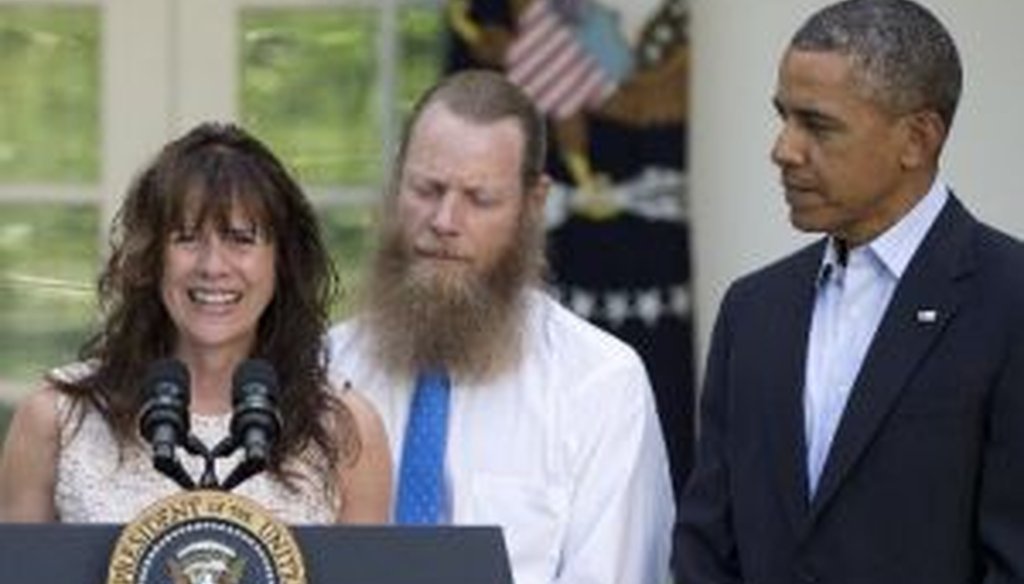Get PolitiFact in your inbox.

Jani Bergdahl and Bob Bergdahl attend a news conference in the Rose Garden with President Barack Obama on May 31, 2014, to announce the exchange of their son, U.S. Army Sgt. Bowe Bergdahl, for five Afghan detainees held at Guantanamo.
President Barack Obama said he had no apologies for the surprise release last weekend of U.S. Army Sgt. Bowe Bergdahl, who had been held by the Taliband for nearly five years.
The deal that released five Afghan detainees from the naval prison at Guantanamo Bay in exchange for Bergdahl, Obama said, was "the right thing to do."
But the president went further, citing "this basic principle that we don’t leave anybody behind – and this basic recognition that it often means prisoner exchanges with enemies – is not unique to my administration. It dates back to the beginning of our republic."
We won’t be putting Obama’s claim to the PolitiFact Truth-O-Meter, but we thought the issue was important enough to take a deeper look into the president’s assertion that U.S. soldiers, living or dead, are never abandoned once a conflict ends.
The most formal expression of this ethos traces to 1974, when Chief of Staff and Army Gen. Creighton Abrams ordered the formation of the Ranger Battalions, according to the Army Rangers’ website.
Abrams ordered that a code of ethics be developed as a way to bind through loyalty the individual to his fellow soldiers. Included in the code is this dictate: "I will never leave a fallen comrade to fall into the hands of the enemy and under no circumstances will I ever embarrass my country."
So for at least the past 40 years, one branch of the service has lived by a written creed that no one will be left behind.
Formal efforts to retrieve the remains of U.S. soldiers, however, far predate the Ranger Creed.
In 1954, for instance, the Defense Department, working with the United Nations, started Operation Glory, an effort to repatriate all casualties and prisoners of war from the Korean War.
Of the 1,868 American remains transferred, 848 unidentified remains were buried as "unknowns" at the National Memorial Cemetery of the Pacific in Hawaii.
After World War II, the federal government launched the Return of the World War II Dead Program. It was intended, according to the Defense POW/Missing Personnel Office, to "locate aircraft crash sites, comb former battlefields for isolated graves, and disinter temporary military cemeteries around the globe."
The effort employed about 13,000 personnel and cost $163.8 million in wartime dollars.
Since then, Defense Department historians have developed a comprehensive database of service members whose remains were not recovered or identified after the war.
It’s paying dividends in terms of the ongoing location and return of soldiers’ remains. Since late May alone, the remains of three soldiers reported missing in Korea have been identified and returned.
For writer George Galdorisi, the fact that the creed is not often committed to paper is beside the point.
"It doesn’t have to be written in bronze letters on the front of the Pentagon," he said, "to stand as an unspoken promise among soldiers and officers."
Galdorisi, along with co-author Thomas Phillips, has, literally, written the book on the subject. Their 2009 work, "Leave No Man Behind: The Saga of Combat Search and Rescue," recounts efforts to retrieve soldiers stranded behind enemy lines in nearly every American conflict.
"One of the most difficult undertakings involved Union cavalry riding around and behind enemy lines to get captured soldiers," Galdorisi. "It was very dangerous stuff."
During the Revolutionary War, both sides accused the other of mistreating prisoners. Because the Americans were viewed by the British as rebels, it wasn’t until 1782, six months after Yorktown, that Parliament passed a law designating Americans as prisoners of war, allowing them to be legally detained, released or exchanged, according to historian William R. Lindsey. Prior to that time, prisoner exchanges were handled informally by individual officers on the battlefield.
Ancient armies had practices of their own along these lines, with a basic distinction between the living and the dead, according to Nathan Rosenstein, professor and vice chair of the History Department at Ohio State University.
"A proper burial or cremation was extremely important for all ancient soldiers, so recovering the dead after a battle and seeing to their last rites was the final stage in any ancient combat," Rosenstein wrote in an email.
The living often received less due.
After Hannibal defeated the Romans at the Battle of Cannae in southeast Italy in 216 B.C., for instance, the Roman senate refused to pay ransom for the prisoners taken by the Carthaginian general -- both because it would enlarge Hannibal’s war chest and "because it sent an unmistakable message to the rest of Rome’s soldiers: conquer or die," he wrote.
Now, with Bergdahl back in American hands, the rest of what’s already been a controversial situation will play out.
However, when the president claims the act of retrieving him comports with a tradition dating to the founding of the republic, he seems to be standing on very solid ground.
Our Sources
Telephone interview with George Galdorisi, co-author, "Leave No Man Behind: The Saga of Combat Search and Rescue," June 6, 2014.
Email from Nathan Rosenstein, professor of history, Ohio State University, June 5, 2014.
U.S. Department of Defense website.
U.S. Army Ranger website.
William J. Lindsey, "Treatment of American Prisoners during the Revolutionary War," 1969.













































